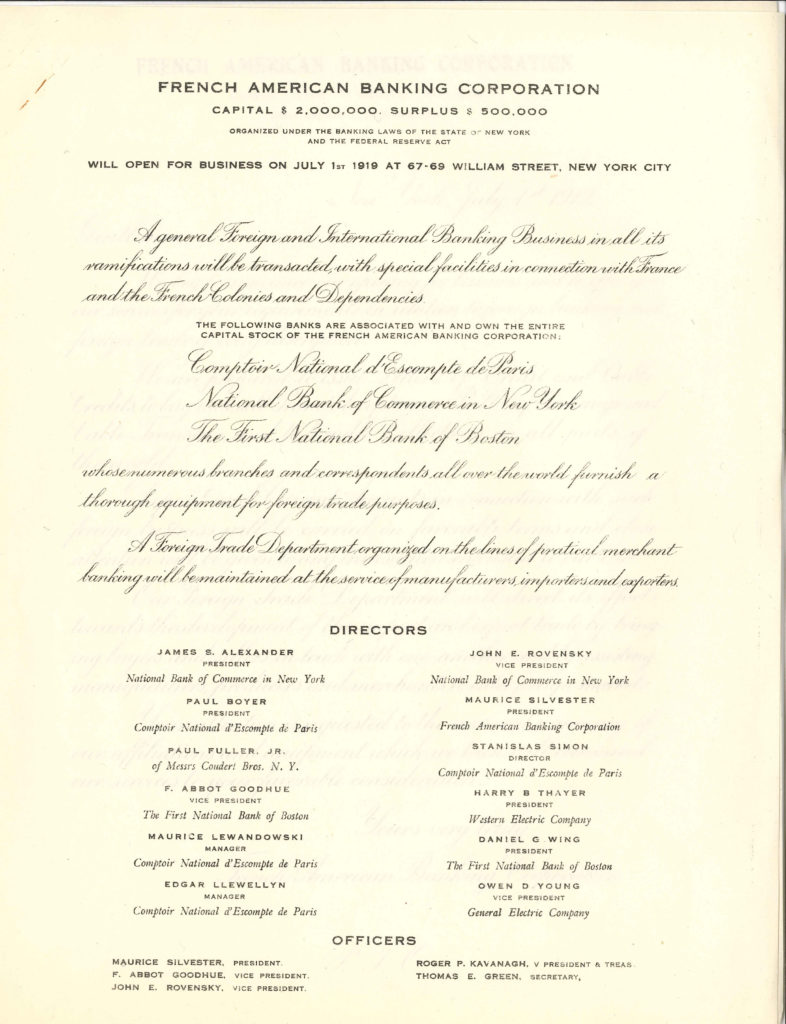After opening its first office in San Francisco in 1877, the Comptoir national d’escompte de Paris wanted to expand its presence in the United States. The goal became a reality in 1919 with the founding of the French American Banking Corporation (FABC).
A strong presence in the United States
The Comptoir national d’escompte de Paris (CNEP) was established in the United States in the 1870s. However, starting in 1898, the economic and regulatory environment negatively impacted the profitability of its branches in San Francisco, New Orleans and Chicago. This led CNEP to gradually close all of its American branches and keep only a representative office in New York from 1903 onwards… However, the bank was still very interested in the American market. It sent one of its executives, Maurice Lewandowski, on a fact-finding mission in 1912, which was extensively reported in the New York Times. After the First World War, CNEP explored ways to make its presence in the country more permanent. It developed ties with American banks and reached an agreement with two of them. The French American Banking Corporation (FABC) was founded in July 1919 and was the fruit of a partnership with the First National Bank of Boston and the National Bank of Commerce.

The FABC, a flourishing subsidiary
The FABC had two million dollars in capital, half of which was held by CNEP. The other half was held equally by the two American partner banks. The chairmanship of the FABC was reserved for CNEP, which appointed Maurice Sylvester, its former representative in the country and the former director of the San Francisco branch. CNEP was the first major French bank to have a permanent presence in the United States. It quickly became the leading partner of French companies in the U.S. The FABC’s deposits grew rapidly, from $2.3 million in 1920 to $75 million in 1930. That same year, Eugene W. Stetson, a well-known American banker and businessman, was appointed Chairman of the Executive Committee, further cementing the FABC’s prestige in the banking world.

Adapting in order to prosper in the United States
The FABC grew quickly and autonomously of the founding establishments. However, it was essential that CNEP hold its own in the United States. In 1920, the bank decided to maintain a dual structure in the United States, operating indirectly via the FABC and directly via a representative in New York. In addition to granting loans to its French merchant clients in the United States, CNEP also gave advances to American businesses selling on credit to French companies. Among others, it financed cotton trading companies selling goods in the American market both via its correspondent banks in the United States and directly.

In the 1930s, the FABC was forced to redefine its business; the American economy crashed in 1929 and the bank had to ensure its own survival. Business handled by French companies was given priority, to ensure a high level of financial liquidity. The subsidiary was in high demand to finance French purchases of raw materials. As a result, it returned to its original vocation of serving French clients. The FACB met its objectives and developed its presence in the United States. It was acquired by BNP in 1971. Given its special status, the FABC couldn’t easily provide loans to major American companies or accept deposits from residents, which is why the bank opened a branch in New York in 1976.












